Who Told Us That History Is Dead? It’s Very Much Alive, In Our Faces, and We Don’t Like It.
As someone who has been privileged to help run history & preservation organizations for the last 30 years, I feel compelled to call out, from my limited experience, what I see as not only my own, but external institutional bias, racism in the preservation field.
Please don’t respond defending preservation or historic districting, or Main Street Preservation Projects etc. I know there are good things about the field – but these have come later in its life and are exceptions rather than the underlying structure to the effort.
- Preservation is essentially an elitist, class and racially divisive activity whose result is a form of economic bias and segregation.
- History sites can perpetuate a divisive form of nostalgia that supports and validates racism and exclusion.
- Preservation can limit inclusion and perpetuate racial & social bias by regulating cultural narratives to simple themes.
- Historical regulations, district codes, and Preservation restrictions can be latently economically restrictive and culturally exclusionary, benefiting only those individuals who can afford the added costs, thus ensuring a form of aesthetically gated communities that reflect the dominant culture.
- Historic districting and preservation code requirements can be a contemporary form of “redlining” which excludes a diverse economic group of people from land ownership.
- Preservation is susceptible to the harshest form of capitalism in that only those historic sites that are targeted with money actually get preserved. Preservation choices are a matter of economics, not just history. The most revealing, unglamorous sites have rarely survived, nor have they been preserved.
- As Preservation has become more professionalized and can require a four-year degree, college has become more expensive and thus constricts the possibility of a racially, culturally, and economically equitable pool of professional practitioners. As a result, professional practices are sometimes biased.
- Preservationist, right now today, need to stop fetishizing the built environment and begin considering how preservation itself is part of the problem.
- Look at the money in Preservation. A budget reflects our priorities. Money goes where it is told. There is nothing natural about the market economy or what gets preserved. Wealth Preserves Wealth.
- Language as a tool of bias in Preservation with a weak notion of the appearance of diversity rather than full systemic representation. *
As Preservationists, We Must Do Better.
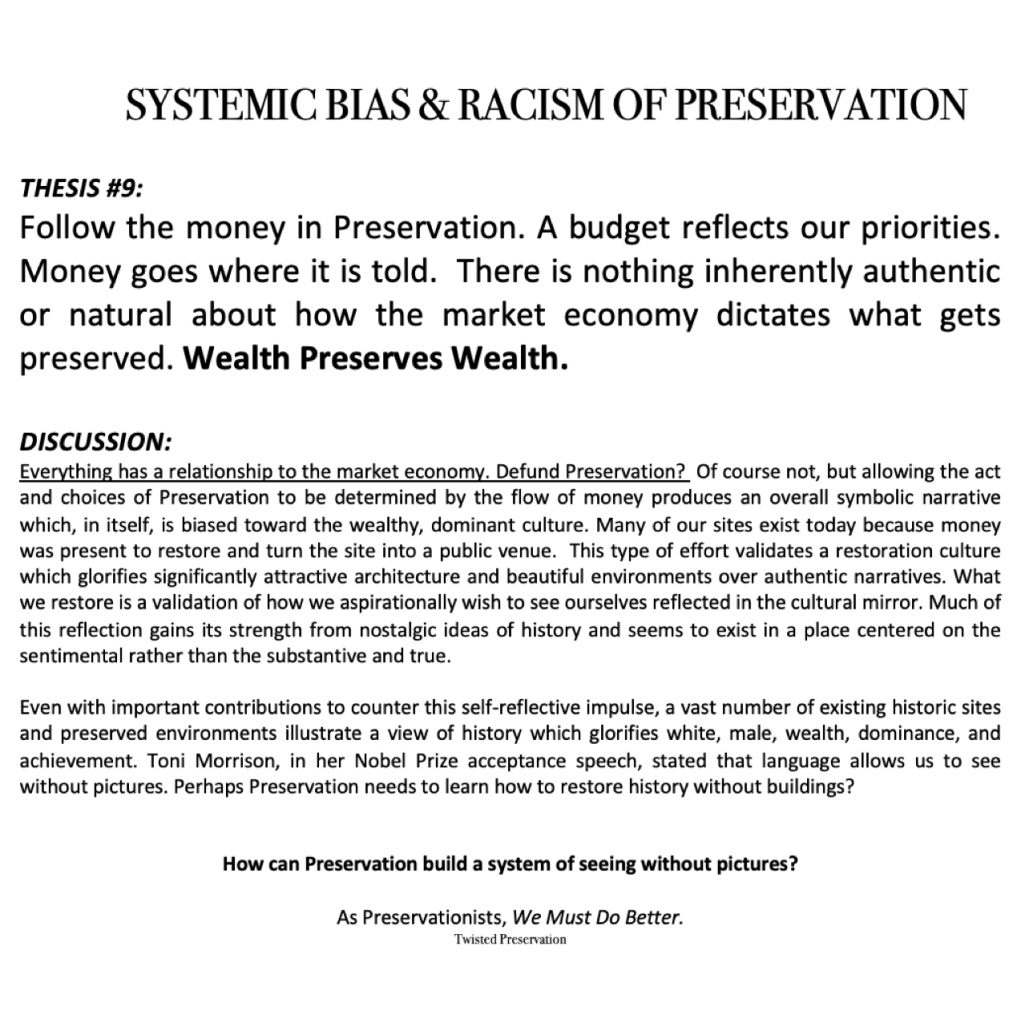
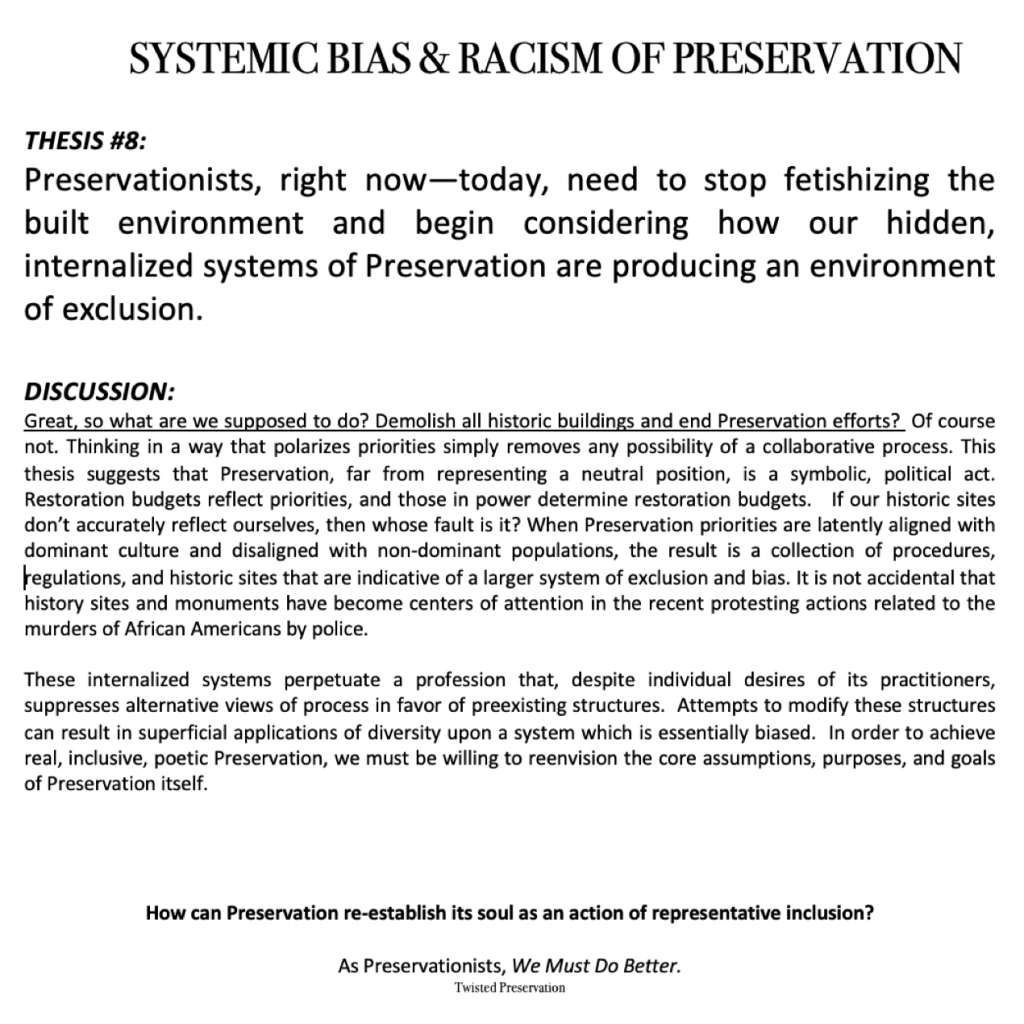



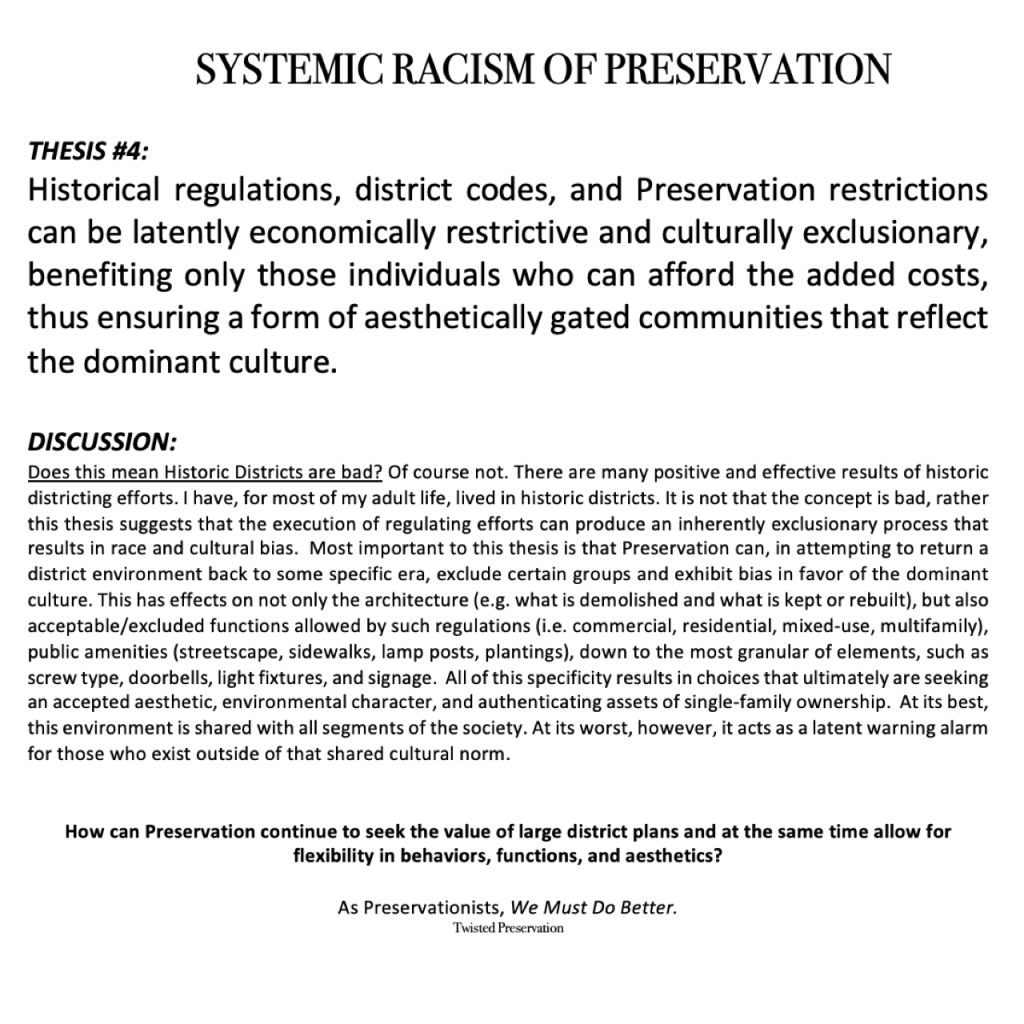
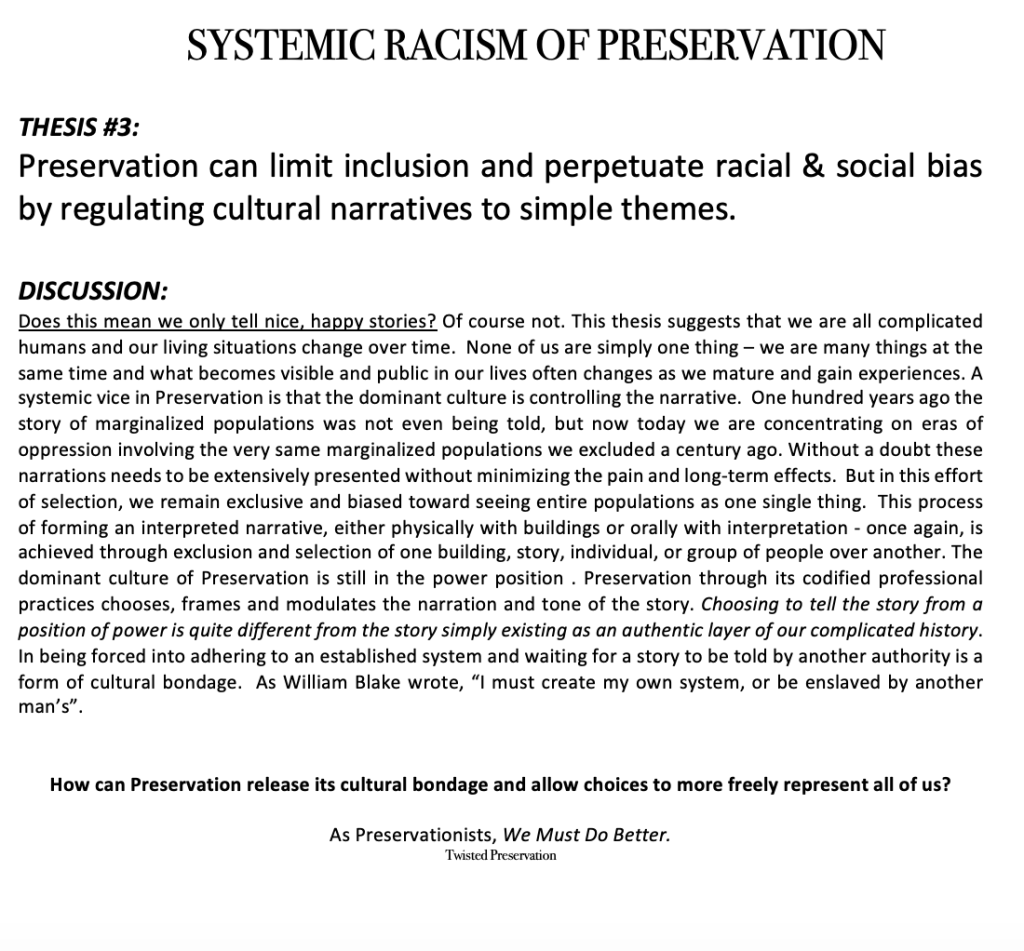
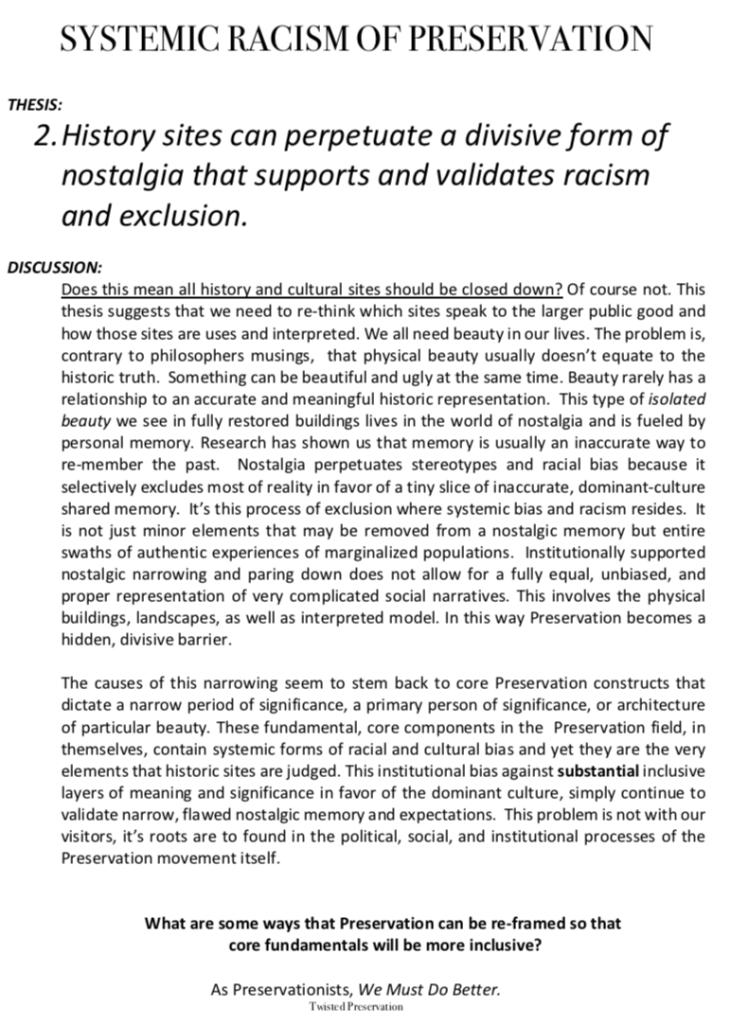
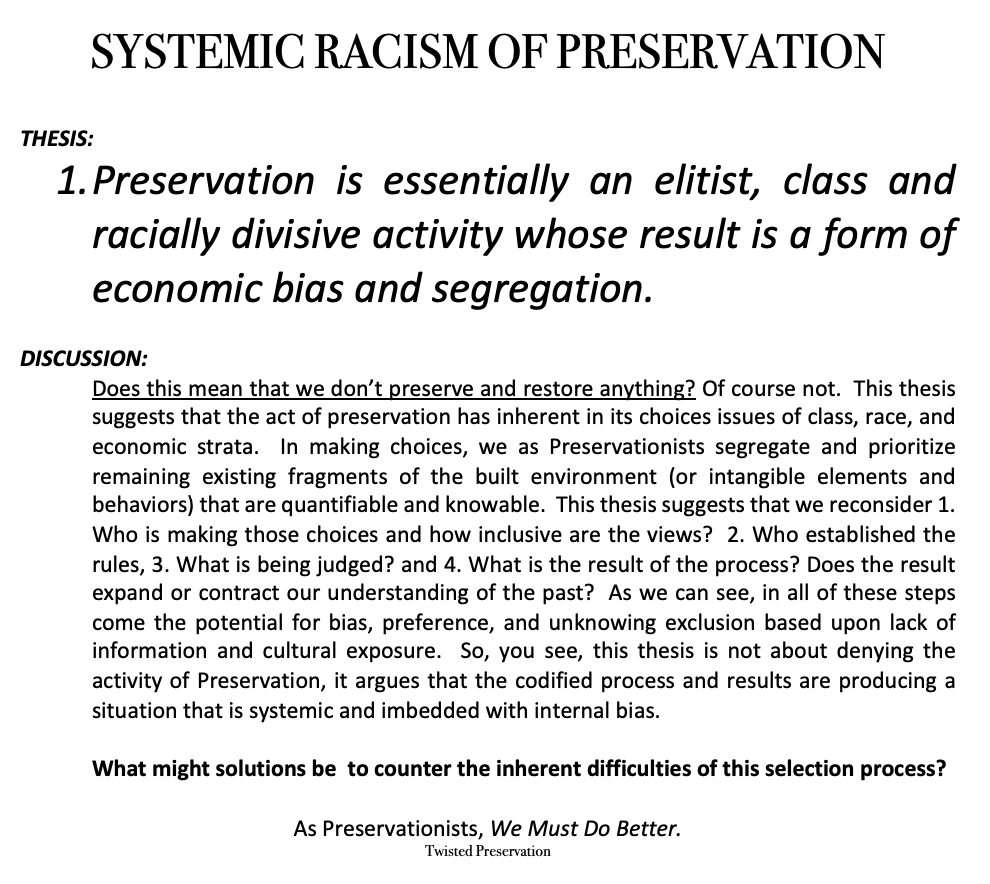
These posts were written by Franklin Vagnone, Twisted Preservation and edited by Samantha Smith, Gate City Preservation
I have worked with historic preservation projects for years and this is the most eloquent statement of what I have felt for a long, long time.
LikeLike
Thank you. I would be happy to be wrong.
LikeLike
Well said.
LikeLike
You raise many excellent points but I would push back on the suggestion that historic districting is a form of redlining when in New York City you have black and minority homeowners and renters in Brooklyn and Upper Manhattan begging for the attention of the Landmarks Preservation Commission to calendar their neighborhoods.
LikeLike
Thank you for your comment. And YES That’s why I mentioned the good in a lot of these points. I am not absolutely saying that good does not exist in preservation – I love history and preservation! I think you may know that I lived in NYC for last 10 years and I am aware of great work by Historic District Council and LPC. It is not the act of districting that I wish to reconsider, it’s the expectations and codes after the fact. We must also realize that NYC is always an exception – not the rule – as preservation in NYC has been exemplary at landmarking a wide variety of structures (Stonewall to name just one).
LikeLike
There’s a lot of good food for thought here. While preservation can be a flawed tool, it is a tool that can be used to positive and negative ends. Regarding historic districts and designation, at NY SHPO we’re increasingly seeing historic district projects (local, state/national register) led by communities of color. I’ve helped shepherd through several projects in recent years where local groups have pursued preservation designation with the aim of exerting more control over their communities and pushing back against developers. A few examples are Bethel Christian Avenue HD, SANS (Sag Harbor Hills, Azurest, and Ninevah Subdivisions) HD, and Dorrance Brooks HD. People of color have been historically wary of institutions and state agencies, and not unreasonably so, but I am hopeful this trend will continue. At its best, preservation is about sharing and preserving everyone’s stories, not just the prettiest and least “controversial” ones.
LikeLike
There’s a lot of good food for thought here. While preservation can be a flawed tool, it is a tool that can be used to positive and negative ends. Regarding historic districts and designation, at NY SHPO we’re increasingly seeing historic district projects (local, state/national register) led by communities of color. I’ve helped shepherd through several projects in recent years where local groups have pursued preservation designation with the aim of exerting more control over their communities and pushing back against developers. A few examples are Bethel Christian Avenue HD, SANS (Sag Harbor Hills, Azurest, and Ninevah Subdivisions) HD, and Dorrance Brooks HD. People of color have been historically wary of institutions and state agencies, and not unreasonably so, but I am hopeful this trend will continue. At its best, preservation is about sharing and preserving everyone’s stories, not just the prettiest and least “controversial” ones.
LikeLike
I have zero experience with historic preservation but the insight you provide allows a lay person, such as myself, to gain a rare and fascinating glimpse into your work, albeit from a distasteful, but necessary perspective.
I look forward to writing out a proper reply but I just don’t have the time at the moment.
I’m leaving this very brief comment to simply say thank you for taking the time and opening it up to the public, which I can’t imagine doesn’t come with some amount of risk. You are clearly a deeply empathic individual and I hope this gets the attention it deserves.
LikeLike